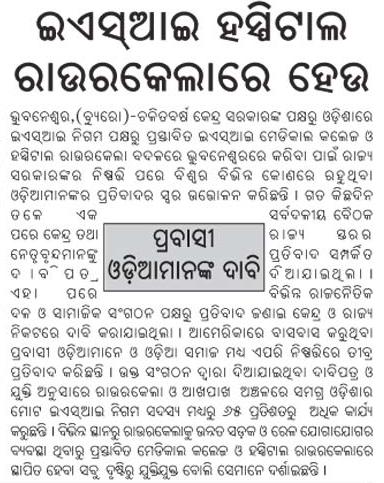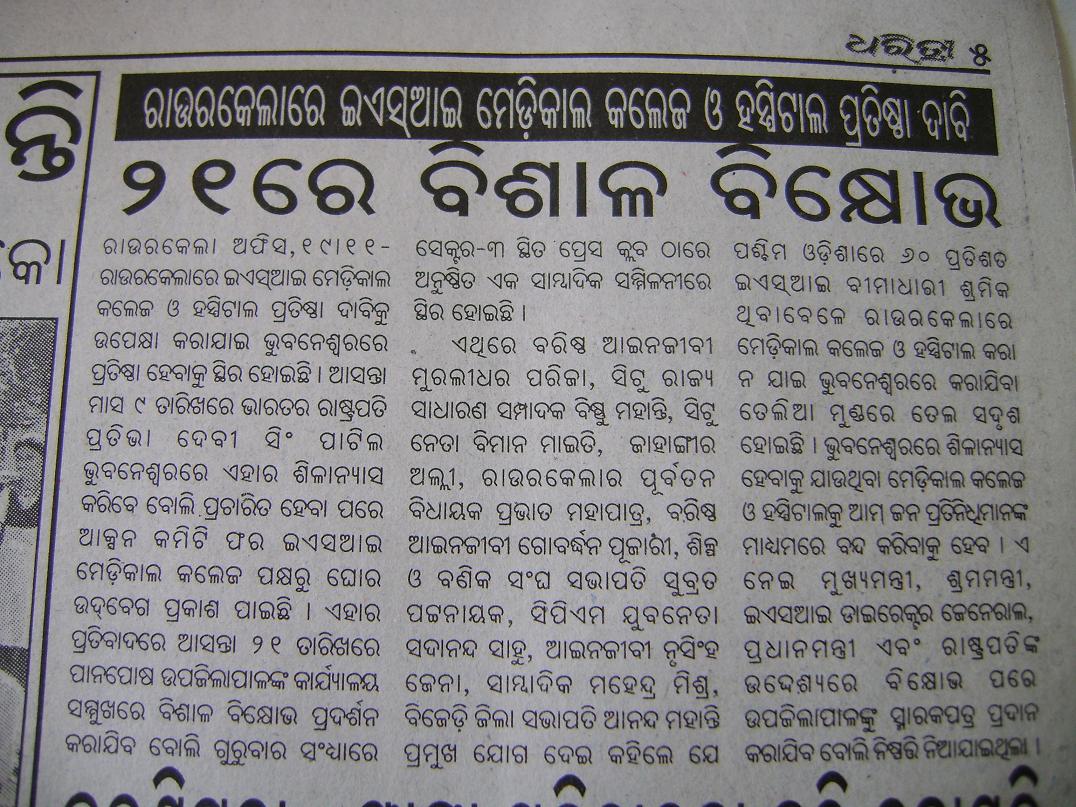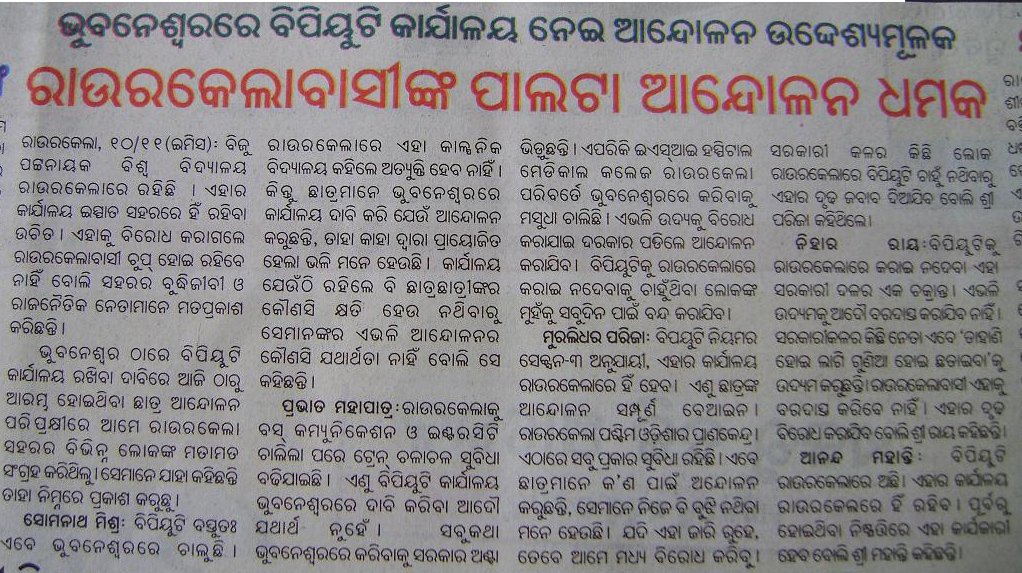Author Archive
I came across this ad in Samaja today.
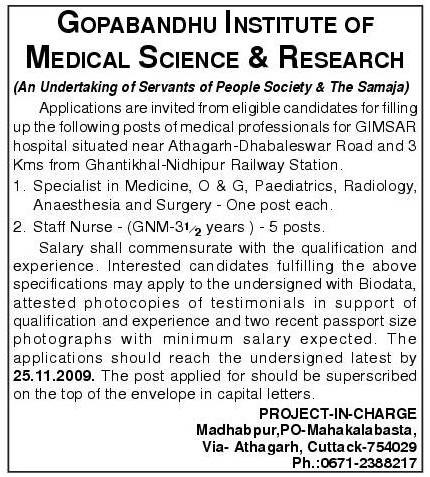
Looking for more information on this institute I came across the following in the page http://www.thesamaja.com/content.php?key=4.
About 80% of the net profit of The Samaja is spent for the welfare activities of the people of Orissa by way of extending stipend to needy students, by helping the patients and victims of natural calamities and through miscellaneous charity and donations. A large amount goes to the Gopabandhu Institute of Medical Science and Research which is in the verge of completion at Athgarh, Orissa.
Looking in Orissa links, I found the following in https://www.orissalinks.com/archives/245.
“The Samaja Group (Lok Sevak Mandal)” has shown interest to establish a medical college cum hospital in Cuttack district.
So perhaps Gopabandhu Institute of Medical Science & Research may some day become a medical college.
Just came across the following ad in nijuktikhabar.net. So it seems this institute has or about to start a nursing college.
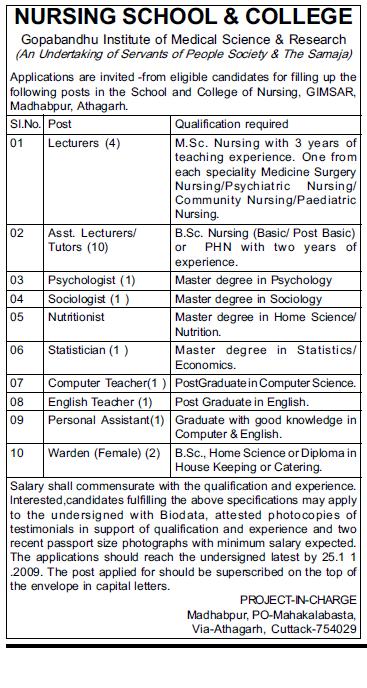
The following news item from Samaja better reflects the current status.
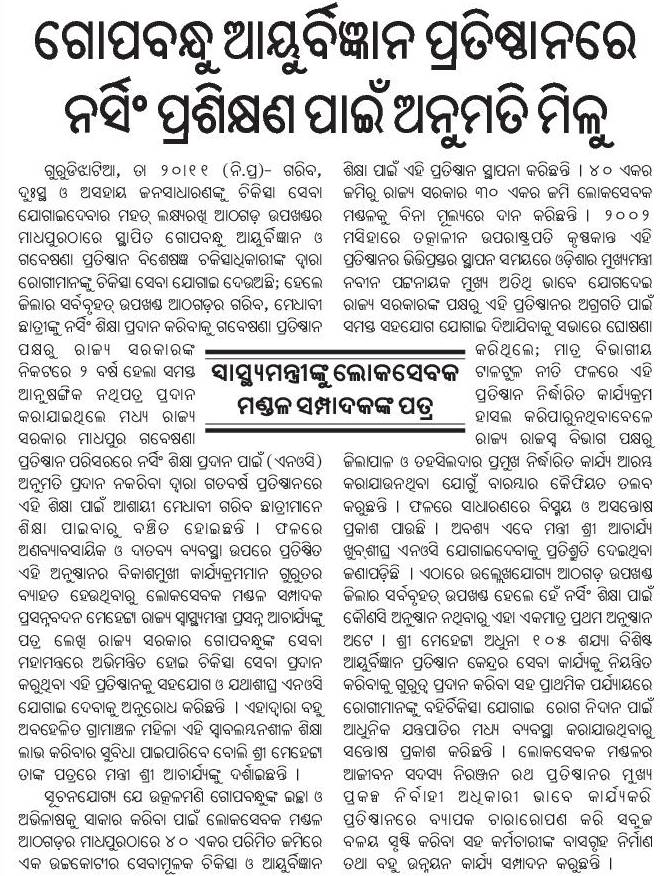
November 21st, 2009
Following is an excerpt from the blog entry at Education-In-India.
… some details about the Azim Premji University (APU).
- The APU will be an institution of excellence in the area of education to develop outstanding education thinkers & leaders, and also serve as a think tank for long-term education change and sustainable development. Akin to the IITs, AIIMS, IIMs and the NLSUI respectively focussed on Science & Technology, Medicine, Management and Law, the APU will in effect be an IIE focussed on Education.
- The APU’s vision is to promote, conceptualize and create a paradigm shift through development of outstanding leadership, research, knowledge and ideas for education and allied development sectors.
- The objectives of the APU include
- Creating Intellectual Capital: through research based theory and outstanding, creative and socially committed leaders and thinkers. Expand the frontiers of knowledge in education and allied disciplines
- Practice informed by sound theory: Serve as a national education resource center and present an alternative authentic voice for educational and social change
- Demonstrating models for effective development of teachers and education leaders
- The APU has been set up through a section 25 company and will be autonomous and self-funded with no dependency on funds from the Karnataka Government.
- The Azim Premji University Ordinance 2009, was passed by the Karnataka Government in November 2009.
- The APU is being set up on 50 acres of land in Sarjapur, near Bangalore. The land is being provided by the section 25 company, which is acquiring it directly from the owners.
- It will be a fully residential university.
- The APU will not be aiming to recover all its expenditure from tuition fees. Any budgetary gap between income and expenditure will be bridged by funds provided by Section 25 company being established by Azim Premji.
- The first students will join the university in 2011. The APU will start by offering masters level courses and eventually also run a Ph.D. program.
Two lessons from the above:
1. Orissa should move fast on Vedanta University so that it does not lose the first movers advantage to efforts like above that are also backed by people with deep pockets.
2. Orissa should push the upgradation of the existing five Regional Institutes of Education (one of which is in Bhubaneswar) to National Institutes of Education.
November 17th, 2009
Following is an excerpt from a PIB release.
… the Union Health Minister Shri Ghulam Nabi Azad expressed concern over dilution of original role of AIIMS due to heavy patient load. He said for bringing the research and innovation to the fore it is important to decongest the institute. Outlining his strategy for this Shri Azad said that the establishment of 8 AIIMS like institution and upgradation of 19 government medical colleges along with strengthening of health infrastructure at rural, district and state level will reduce the pressure on AIIMS. Speaking with the Journalists after the function the minister said that most of the clearances for the AIIMS like institutions have been procured and civil tenders are being issued. He informed that taking cue from his experience in Jammu and Kashmir where he was the Chief Minister he has incorporated a strong monetary incentive for fast completion of these projects. The Hospital – OPD complex is to be built in 24 months. The Minister informed that incentive upto Rs 10 crore will be given for the early completion of work.
November 17th, 2009
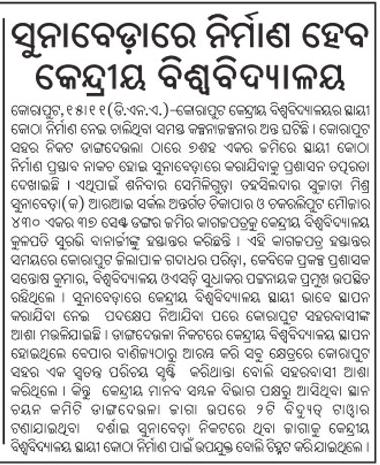
November 16th, 2009
Following is an excerpt from a report in Expressbuzz.com.
Ayurvedic treatment, for instance, is now a Rs 8,000-crore industry, and growing at 20 per cent annually. And so you have Ramesh Vangal, former head of Pepsi India, having established an ayurveda firm, now merging it with Coimbatore Arya Vaidya Pharmacy to become the largest ayurveda company in India. Yash Birla has taken a majority stake in Kerala Vaidyashala, the therapy chain. Ayurvaid Hospitals, promoted by a Kochi-based group, got equity investment of Rs 4.5 crore last year from a US-based fund. And the Tata Group has now agreed with an NGO to jointly set up an Institute of Ayurveda Integrated Medicine near Bangalore, to offer formal graduate and postgraduate degrees, beside a 100-bed ayurveda and yoga hospital, plus research and drug production. The Tatas are putting in Rs 34 crore for the IIT-type institute. There are similar plans from the Mata Amrithanandamayee trust.
All this is excellent news, for the simple reason that when business gets into the picture, documentation and systems and reports have to be put in place. This has been the problem all along with what are loosely called alternative systems of medicine to standard allopathy. Each practitioner has his or her own way of doing things and you have to accept this on trust. And if something works, there is no publicly accessible system of how and why. One outcome has been the mutual scorn between allopathy and these other systems of treatment, with close to no attempt at reaching out to each other or researching if each can usefully learn from the other and so, improve itself. The public would benefit enormously if they could go to one place and get the combined benefit of different systems of knowledge working in tandem. You will never get this unless these processes are all systemised, subject to peer and public review, and are allowed to be replicated in a laboratory setting: this is the way knowledge progresses. If business and investors take a hand, this process should get a push. As, for instance, with the proposed Tata university.
November 16th, 2009
Following is an excerpt from a report in Business Standrad.
The national design policy had recommended setting up institutes on the lines of NID in various parts of India to promote design programmes. Under this initiative, the government has narrowed down on Andhra Pradesh, Assam and Madhya Pradesh for setting up the new NIDs in the next two to three years. Cities like Hyderabad, Jorhat, Bhopal and Gwalior are some of the cities that have been shortlisted. An NID will also be set up in the Northern part of India for which target cities are yet to be finalised.
Interested state governments have offered around 30-50 acres of land for setting up the institute. Each NID will gradually have an intake of 1000 students. The national design policy had stated that public-private partnership mode could be an option for setting up these new institutes but sources say that no call has been made by the government for private partners as of now.
At present NID has campuses in Ahmedabad, Gandhinagar and Bangalore. The institute runs 8 programmes in the Ahmedabad campus, 5 in Gandhinagar and 3 in the Bangalore campus. The Bangalore campus is the institute’s R&D campus where there are 30 students for the three programmes.
November 16th, 2009
Update: See also https://www.orissalinks.com/orissagrowth/archives/4308.
Rourkela is the second largest metropolitan area of Orissa with an official metropolitan population of 550,668 but perhaps much more (at least 700 K) if one takes into account nearby places like Biramitrapur and Rajgangpur. It is probably the most cosmopolitan area of Orissa. Because of its steel plant it has world-wide name recognition. It has a lot of young talents; I am told that Rourkela youngsters have done much better in entrance exams like IIT JEE than from other parts of Orissa. Rourkela and the Sundergarh district have produced many national hockey players (both male and female), some of whom have gone on to captain the Indian national side.
Being an important station in the Mumbai-Howrah line, Rourkela is very well connected to both. The National Institute of Technology at Rourkela is often ranked among the top 5 NITs of the country; in recent years it has done much better and is in the process of starting a business program. Rourkela also has two private engineering colleges and at least one more is in the works. Rourkela has at least two good magament schools: Rourkela Institute of Management Studies (sometimes ranked nationally) and Indian Institute of Production Management, Kansbahal.
Overall, Rourkela has the potential to be a Tier II city of India at the level of Vizag, Chandigarh, etc. But unfortunately, that has not happened so far and active organized efforts need to be made to achieve that.
So here I will list some of the things that should be pursued so that Rourkela becomes a Tier II city of India.
Knowledge and HRD aspects:
- Metropolitan University: Rourkela is perhaps the largest metropolitan area of the country, or may be the whole world which does not have a general university. This needs to be rectified at the earliest. IMHO, the best model to follow would be of Delhi University. So a Rourkela Metropolitan University should be established with graduate programs as well as with a few constituent colleges spread (offering Bachelors as well as Masters degrees) across the metropolitan area, but with no affiliated colleges. The exisiting government colleges in Rourkela (Govt. College, Rourkela; SG Women’s, Rourkela and Rourkela College) would be made constituents of this university.
- Medical College: Although a WODC sponsored PPP-based medical college is in the works, we must continue pursuing an ESIC medical college here. SAIL, which is making a medical college in Bokaro, should also be pushed to establish a medical college here.
- BPUT: BPUT must become fully operational from Rourkela.It needs to have real departments and centers and offer its own courses. It should be expanded to have programs in Science and Humanities.
- Research Centers: The state should pursue one of the central government departments such as CSIR, DAE, Sc & Tech, etc. to open a research center in Rourkela.
- Centrally funded University: At some point a centrally funded university should be pursued for Rourkela.
- More private institutions: Rourkela has the population base and the amenities that metropolitan areas offer to have more private institutions such as engineering colleges, management institutions etc. A multi-pronged apporoach should be taken.
- Local big industries should be cajoled to participate in this. For example, SAIL is also planning an engineering college in Bokaro. They should be pushed to have one in Rourkela.
- Local people should also open private institutions on their own.
- Educational foundations inside and outside state that have developed good private institutions should be approached and invited to open institutions in Rourkela. Inside Orissa, institutions like Silicon and NIST should be approached.
- STP: The STP at Rourkela should be expanded.
- IT/BPO: Because of the cosmopolitan nature of Rourkela, it would be a good place for BPO and call center operations. This should be pursued.
- Sports Institute/University: Sundergrah district is considered by many to be the Hockey cradle of India, both in men’s and women’s hockey. It has produced both Men’s and Women’s hockey team captains in Dilip Tirkey and Jyoti Sunita Kullu. Orissa government should pursue to establish a National Sports Institute (of the kind in Patiala) in Rourkela. It should include programs in physical training, coach training, official training etc. This would specially contribute in the enhancing the employment opportunities for Adivasis who constitute 50.74% of Sundergarh’s population.
Connectivity Aspects:
- Rail Connectivity -Trains: While the connectivity to Mumbai and Kolkata is marvelous, connectivity to other places needs improvement. Dilip has a good list of new trains needed for Rourkela at http://rourkelarail.wetpaint.com/page/DEMANDS. This list is:
- Rourkela-Bhubaneswar Intercity Express( Day Time)
- Rourkela-Berhampur Gajapati Express
- Rourkela-Secundarabad/Hyderabad Express
- Trains to New Delhi from Bhubaneswar via Rourkela OR Rourkela-Nizamuddin/New Delhi Express (Any extension of Ranchi-Hatia or Tatanagar trains will also work)
- Trains to Patna and Eastern U.P.
- Rail Connectivity-Others: The Talcher-Bimlagarh line must be fast-tracked.
- Roads: The 4-laning of the state highway 10 connecting Sambalpur and Rourkela must be expedited.
- Air Connectivity: Rourkela airport must be made functional with commercial flights at the earliest.
Metro area:
- A larger metropolitan area for Rourkela that includes Kansbahal and Rajgangpur in the west and Biramitrapur in the North must be formally established.
- The state government should pursue Rourkela to be included in JNNURM.

(The above is from Google Maps.)
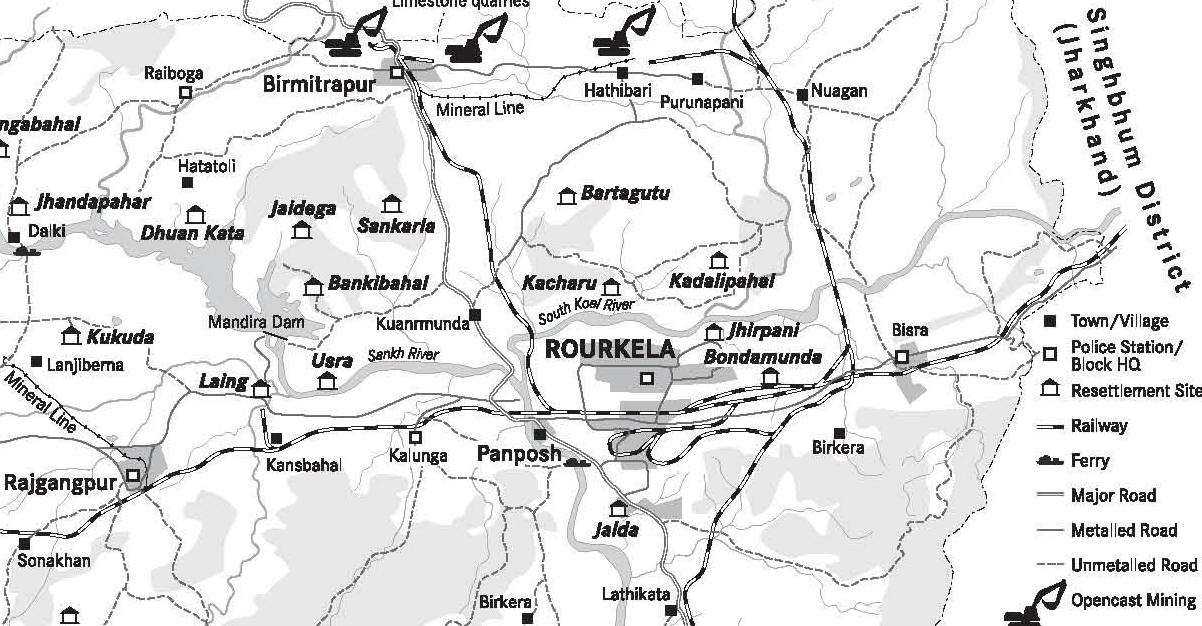
(The above is from "sarini: Occasional papers, No. 4, Adivasis of Rourkela")
Work in Progress…
November 15th, 2009
Update: A Business Standard report has some additional information on this. Following are some excerpts.
International Management Institute (IMI), a New Delhi-based B-school, will invest Rs 50-crore in setting up its campus on 15.8 acres of land at Gothpatna on the outskirts of the city.
… Initially, IMI-Bhubaneswar would have an intake of 60 students for the Post Graduate Diploma in Management (PGDM) programme which will be introduced from July 2010.
To start with, there would be 10 full-time faculty members besides visiting faculty for the maiden PGDM batch of IMI-Bhubaneswar. IMI-Bhubaneswar would have a maximum student intake of 500 and a pool of 50 full-time faculty members once it is fully commissioned after four years. Addressing media persons here, C S Venkata Ratnam, director, IMI-New Delhi said, “We will commence our first PGDM programme at the Bhubaneswar campus from July 2010. The campus will be fully residential with a separate hostel for working executives.”
Students will have to pay around Rs 10 lakh for pursuing the full-time management programme which includes the cost of the hostel. Apart from PGDM programme, the Bhubaneswar campus of IMI would offer executive PGDM programme for working executives. Plans are also afoot to introduce a porgramme in services marketing.
Following is an excerpt from a report in Economic Times.
New Delhi
: Commemorating its 30th anniversary during 2010-2011, the International Management Institute (IMI), New Delhi, has announced the launch of its second campus at Bhubaneshwar in Orissa. Located at the IDCO Institutional area in Gothapatna, Bhubaneshwar, adjacent to IIIT, Bhubaneshwar and NALCO Research Centre, the new campus is spread over 16 acres of land.
Speaking on the occasion, C.S. Venkata Ratnam, director, IMI New Delhi, said, “Subject to getting approval from AICTE, we will commence the first PGDM program in July-Aug 2010.” The campus will be fully residential and function as an autonomous business school. “Besides PGDM programs, IMI Bhubaneshwar will also have centers for research and executive education,” he further added.
… The new campus will also focus on entrepreneurship development and applied research on public policy into socio-economic issues and best practices in management and governance.
Prof N C Patnaik, IMI, said “We plan to be operational in a short span of 8 months, and the building will reflect the Architecture of Orissa.”
IMI Delhi is among the top business schools in India. I hope the Bhubaneswar campus will achieve similar or greater success.
November 13th, 2009
Following is an article written by respected (I respect him a lot) columnist Sharat Kumar Rout. I found it at http://www.orissadiary.com/ShowOriyaColumn.asp?id=15350.
Vedanta University in Orissa: A victim of selfish politicking
Sharat Kumar Rout
Recently, the central team of a political party visited the Vedanta University project site near Puri and participated in a meeting of the group opposed to the project. The team leaders flayed the BJD government of Orissa to their hearts’ content and declared their firm opposition to the University project. They criticised the state government vehemently for giving away ‘prime agricultural land’ at ‘throw-away’ prices for the proposed University, expressed ‘shock’ at selling of Lord Jagannath’s land for the same purpose and also questioned the very logic behind establishment of a world class University in the Puri-Konark area. Well, they came, they saw and went away happily, believing perhaps that they conquered too. But, apart from providing some grist for the media mill, the whole exercise has gained nothing for the party concerned. What actually has come to fore is its glaring double standards. Inviting this mega University project to Orissa in 2006 was the decision of the erstwhile coalition Government in which three important Ministers, namely, law, Revenue and Higher Education, were from the said political party. Obviously, departments under these three Ministers played a very proactive role as far as the University MOU and the related matters were concerned. For all one knows, these particular Ministers were the main votaries of the University project. The central team of this party is surely not unaware of this fact. But now, because of the political dynamics before and after the last election, the party is no longer in the Government and so, it has just decided to play the role of the opposition to the hilt! This, among other things, clearly underscores the overly political nature of the opposition to Vedanta University project.
If one closely follows the anti-Vedanta University opponents and their modus operandi, it will be apparent that out of the 18 revenue villages coming within the proposed University site, only one particular group of people belonging to a particular village has been at the forefront. That they were never against the University project at the beginning and have been brainwashed by some local politicians to form an antagonist group, is also common knowledge. But this anti-Vedanta University group and its local political leaders have been emboldened over the last two years, because of the sustained support of different political parties, groups and personalities who, for various reasons, are opposed to the Naveen Pattnaik- led Government of Orissa. These political vested interests have naturally been able to create a whole lot of hype and hoopla about an anti-Vedanta University ‘movement’ and this, in turn, has been occupying so much of media space and time The usual shouting brigade consisting of the foreign-funded NGOs, their high-flying activists and the celebrity ambassadors they manage to rope in, has only made matters worse. Irrespective of the merit or propriety of the project opponents’ remonstrations, they succeed in creating or increasing doubt in public mind. The intelligentsia is also easily swayed by the media hype, more so because, in these stressful times no one practically has the time or inclination to be properly informed or think about any particular issue no matter how important it is for the society or the country at large. The cumulative result is that fear, suspicion or anxiety of the local community, whose life will be affected directly or indirectly by the project, is intensified creating more elbow-room for further politicking and the project work is delayed.
It is not to say that the people of the project area do not have any genuine grievances. But, surely there are ways and means of taking care of the grievances without stopping the project work. Besides, if the compensation package for land acquisition and other benefits to be made available to the land losers as per the R&R policy are dispassionately analysed, one can very well see that the possible pros far outweigh the cons. And, it will also be clear that most of the allegations of the project opponents are unfounded and unreal. It is high time that the intelligentsia, the youth, the student community and especially, the impartial opinion makers, shunned the shenanigans of the self-serving politicians and raised their voice in favour of the early establishment of a world class University in our state. It is learnt that an IIT could not be established in our state in the 60’s, due to the lack of foresight of our political class and the decision makers. Now, after more than four decades, one IIT has come to us. If we let go an opportunity like the Vedanta University now, perhaps we will never get another in the next hundred years.
[Sharat Kumar Rout, columnist, cell No: 9337369448, Maytree Enclave,Naharakanta,Bhubaneswar.]
There is also another recent article by Swati. It is at http://www.merinews.com/article/bjps-dissembling-policy-on-vedanta-raises-eyebrows/15787962.shtml. Although I mostly agree with her point of view, all her write-ups in Merinews have been about Vedanta University.
November 13th, 2009
Following is an excerpt from a report in Pioneer. (A similar version also appears in tathya.in)
Leading non-resident Odia (NRO) Sandip Dasverma continues to bat for an ESI Medical College at Rourkela, though the State Government has turned a blind eye to the demand of the people of the steel city. Thanks to the alleged poor leadership of Rourkela, MLA Sarada Prasad Nayak, who is the Minister of Food and Civil Supplies, the demand has not been heeded by the Government. However, justifying his stand, Dasverma has come out with a detailed memo to the Government.
Dasverma says that Odisha’s development should take into account development of all regions of the State. But such a thought process is sadly missing, for which Rourkela as location of an ESI Medical College is being ignored. And this has resulted in regional resentment and regionalism, warned he.
He says Rourkela should have been recommended for the first ESI Medical College rather than the second by the State Government, as recently reported in the media. With Bhubaneswar being the destination of nine other medical colleges, one more would not mean much to the capital city whereas it would certainly matter a lot for Rourkela, which has none, he argues.
Dasverma further adds that Rourkela has the main concentration of Employees’ State Insurance (ESI) Insured persons, which is about 60 per cent, while the other 40 per cent live in and around Cuttack and Bhubaneswar. Rourkela should, therefore, get the priority as location of an ESI Medical College and Hospital, he strongly feels.
He points out that people of four districts, Sundargarh, Keonjhar, Jharsugda and Sambalpur would benefit due to an ESI Medical College and Hospital at Rourkela. Some more insured persons of the contiguous State of Jharkhand would also be benefitted.
He says Rourkela is the heart of Odisha’s tribal north-west and dotted with dirty mining industries.
The following two pieces appear in Sambada and Dainik Bhaskar. They have been obtained from http://www.odiasamaja.org/esic-medical-college-odia-samaja-odisa-development-teams-official-press-release/.

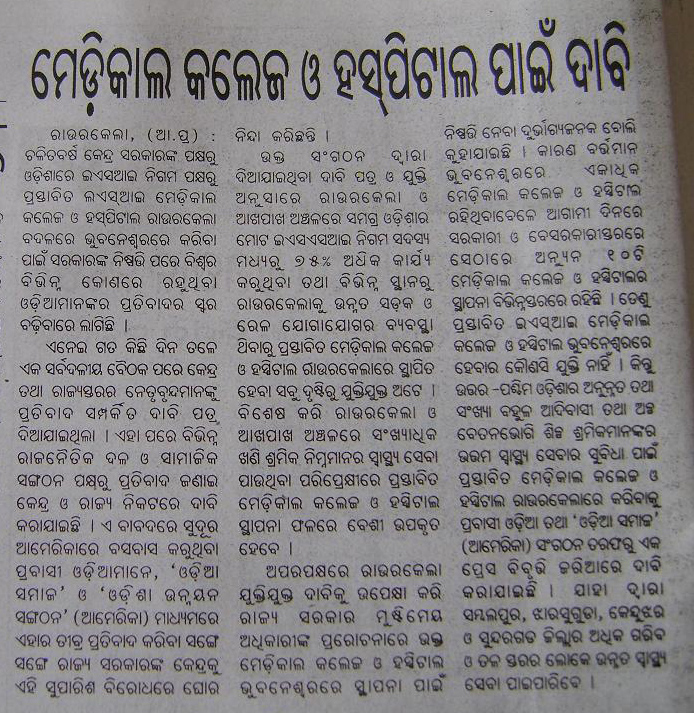
November 13th, 2009
Following is from Today’s Dharitri.
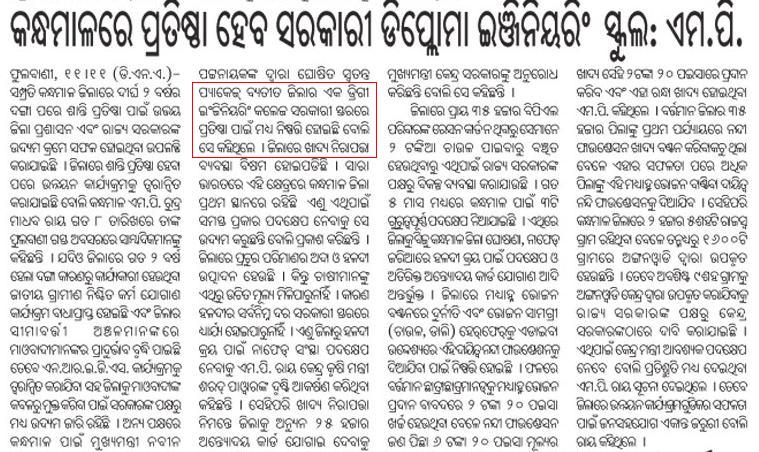
November 12th, 2009
See the table below obtained from http://www.dheorissa.in/DHE/PG.aspx?lnk=Cou.
Continue Reading November 12th, 2009
Following is from the page http://www.dheorissa.in/DHE/Initiatives.aspx?lnk=ini.
To popularise Science education in backward areas Government has decided to open Colleges in the the districts of Malkangiri and Nuapada. Three more Government +2 Science Colleges at Kutra (Sundargarh), Tiring (Mayurbhanj) and Jirang ( Gajapati) are going to be esablished.
November 12th, 2009
Next Posts
Previous Posts



